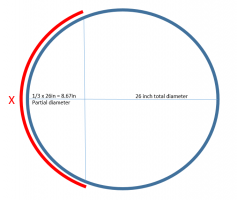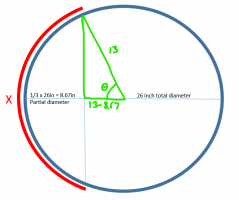|||||||E|||||||
New member
- Joined
- Jul 17, 2022
- Messages
- 5
Locate the center of the circle and join the center and the end-points of the red arc. What is the measure of the central angle.Hello, I'm sure this is easy for y'all, but I can't figure it out. Can you solve for X for the attached?

You need to read circular segment : [imath]h=8.67 in.[/imath]Hello, I'm sure this is easy for y'all, but I can't figure it out. Can you solve for X for the attached?
Is there a tool I can use to do this? I don't have access to any.Locate the center of the circle and join the center and the end-points of the red arc. What is the measure of the central angle.
I have tried to take 1/3 of the circumference, but that was obviously wrong. I'm exactly stuck at knowing how to approach this problem.Please show us what you have tried and exactly where you are stuck.
Thank you for this! R = 13in, h = 8.67in, d = 4.33in. Ø, C, and S = Unknown.You need to read circular segment : [imath]h=8.67 in.[/imath]
Use this right triangle to find [imath]\theta[/imath]:Is there a tool I can use to do this? I don't have access to any.
I have tried to take 1/3 of the circumference, but that was obviously wrong. I'm exactly stuck at knowing how to approach this problem.
Thank you for this! R = 13in, h = 8.67in, d = 4.33in. Ø, C, and S = Unknown.

As shown in the response above (#5), you need to locate the center "approximately" - then apply known trigonometric properties to calculate appropriate unknown variables. You don't need any special tool except pencil/paper.Is there a tool I can use to do this? I don't have access to any.
If the full diameter is 26, how can the partial diameter be 32? It has to be less than 26!!This was very helpful. Thanks!
I think I got it:
View attachment 33437
View attachment 33433
=
View attachment 33438
Look good?
Looks good, except for that mistake of calling the arc length a "partial diameter"!This was very helpful. Thanks!
I think I got it:
View attachment 33437
View attachment 33433
=
View attachment 33438
Look good?
Looks good, except for that mistake of calling the arc length a "partial diameter"!
Here is a GeoGebra drawing of it, for confirmation...
Okay.Wow, yeah...I had a typo there. Partial diameter should have been partial circumference/arc length.
Thanks for the confirmation Dr. Peterson! Really helpful.
For context, this solution will make felling trees really easy. Acquire the diameter of the tree, input into this solution, cut a string the length of the arc length, mark the center point, aim the center point where you want the tree to fall, wrap the string around the tree, mark the end points of the arc length, and that's your hinge point.
